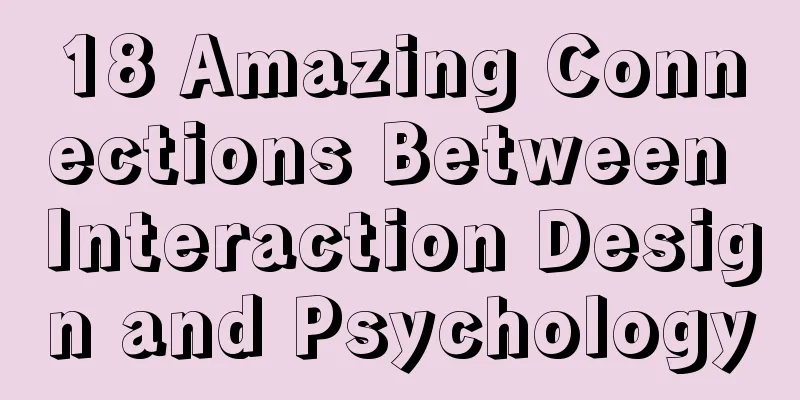18 Amazing Connections Between Interaction Design and Psychology

|
Designers need to understand psychology reading notes The book Designers Need to Know Psychology is very interesting. First of all, it is very simple and any reader interested in design can easily read and understand it. Secondly, it is very real and can bring some interesting memories and thoughts to designers. Finally, this book once again proves how simple yet complex the group of users are that designers have to serve when designing products. . . :) Title: Designers Need to Understand Psychology By Susan Weinschenk The book contains a lot of content, I only record the parts that interest me, as follows. 1. “What others see on your website may not be what you expect. Their personal background, education level, familiarity with what they see, and what they expect to see will affect their observations.” Therefore, never design a product entirely from the designer’s own standpoint and perspective; at the same time, designers need to pay attention to the value brought by user research. 2. “People look for patterns when they recognize objects. Finding patterns helps them process the sensory information they receive quickly. Even if there are no patterns, the human eye and brain will try to create them.” Simply put, when designers design products, there should be rules in them. Whether it is explicit or implicit, there needs to be certain rules to guide users. This can help users use the product more efficiently and comfortably. From another perspective, product design should have a certain degree of control and limitations, and users should not be allowed to operate completely freely. If product design does not have certain rules, users will create their own rules, and the user operations generated at that time will be unpredictable and uncontrollable by designers. 3. “The brain has a specialized area for recognizing faces, and we can’t help but look in the direction that other people’s eyes are looking.” You can verify this point. In fact, it is used a lot in web design. Design is always consistent with people’s natural living world. For example, when you go out and see someone looking at the sky silently, you will definitely look to see if there are any airplanes in the sky. Design comes from life, that's right. 4. “People have preconceived mental models of what they want to see and where it should be. People have specific mental models of where things should appear on their computer screens and in the specific apps and websites they use, and they tend to look at screens with those mental models in mind.” Therefore, in the design process, understanding the user's psychological model and behavioral habits is a necessary step. When designing a product, I personally think it is difficult to satisfy everyone's psychological model. Therefore, most of the user scenarios determined by Persona and Scenario are the main body of the design, and then marginal users are considered to expand the breadth and inclusiveness of the design. The design process of most products should be center first, then periphery, focus first, then diverge.  5. “When people find a font difficult to read, they transfer this judgment to the content of the text, believing that the content itself is difficult to understand or difficult to achieve.” This point is very interesting, users will blame it wrongly. When designers design products, they will carry out a certain degree of decoration after accurately grasping the presentation method and information framework of the core content. If the decoration is unreasonable, users will dislike the decoration, and then will blame the content, thus disliking the product as a whole. So design is very important. There are many users who judge people by their appearance. 6. "Short-term memory is limited. We have all had this experience: when you are on the phone, the other party tells you that you must contact someone immediately and provides the person's name and phone number, but you don't have a pen or paper to write it down, so you have to repeat the number over and over again to help you remember it, and then quickly hang up the phone and dial it immediately to avoid forgetting it. You will find that memory in this situation is not reliable. Psychologists have many theories about the principles of this kind of memory. Some call it short-term memory, and some call it working memory. We call this kind of fast memory that needs to be maintained for less than a minute "working memory." How do people turn working memory into long-term memory? Basically, there are two ways, one is a lot of repetition, and the other is to associate new information with familiar things." In product design, especially ToB product design, a lot is required of the user's working memory. In fact, many process breakpoints occur due to confusion in the user's working memory. For example, when a user operates a cloud service product, he needs to deploy a service. The process is relatively long. The user keeps operating and uses his brain to memorize some operation items that need to be remembered temporarily. When the process is more complicated or requires extra thinking, the user's working memory may become confused, and the entire operation process will encounter a bottleneck. Therefore, when designing a product, it is important to keep users’ thoughts clear and provide them with as few items to remember as possible. It is very important to use reasonable processes, interface designs, and prompts to help users remember and think. Of course, some memories need to be transformed from short-term memory to long-term memory, and at this time it is necessary to help users generate long-term memory. For example, a user's daily job is to operate the interface of a complex information system. After a large number of repeated operations, the user becomes proficient and his operations are very efficient and accurate. The large number of repetitive operations that users experience at this time is a way to generate long-term memory. What impressed me most was that every time I went to take ID photos, the studio staff had to photoshop my photos and then print them out in the appropriate size. The speed and accuracy with which the studio staff used PS surprised even me, a designer with many years of experience. I guess this is what practice makes perfect means. The second method is to connect new information with familiar things. For example, we watch the Spring Festival Gala every year, and the last song is "Unforgettable Tonight". Although we only hear this song once a year, I believe everyone can sing it easily.  7. “People forget things all the time. People don’t consciously decide what to forget.” During the design process, when judging whether users will remember certain content or an operation, you must set the minimum requirement, because you never know when users will forget. Thinking about it the other way around, people will always remember some things, so during the design process, designers should always think about what the product needs users to remember. 8. “The brain can only consciously process a small amount of information at a time. It is estimated that people process about 40 billion pieces of information per second, of which only 40 are consciously processed. A common mistake designers make is to give users too much information at once.” Next time when you have an argument with the product manager about reducing demand, please directly quote the data here: 40 billion, 40, hehe. 9. "Number of clicks is not important, progressive disclosure requires multiple clicks. You may have heard that website design should minimize the number of clicks required for users to get detailed information. But the number of clicks is not important, people are very willing to click multiple times. In fact, if users can get the right amount of information with each click and are willing to continue viewing the website along the design line, they will not notice the click at all. You should consider progressive disclosure design, don't worry about the number of clicks." I have written many times in my articles that design is a very strange subject, which is both rational and emotional. Therefore, any design principles are not necessarily universal, and there is no need to be superstitious. During the user operation process, there is a reasonable process preparation, smooth operation flow, and considerate rhythm control. Even if the user clicks many times to complete a task, he will not feel it is complicated, but feel that he has completed the task very simply. The rationality of a design comes from the designer's own judgment, not purely based on standards. 10. “People’s minds wander 30% of the time.” People’s attention span is very limited, and distraction can happen at any time when users are using a product. Therefore, in the process of designing a product, we must always grasp the user's attention and have a clear understanding of what the user pays attention to, looks at, and cares about in each interface. Secondly, the rationality of the interaction design of the process and interface is very important. After the user is distracted, we need to bring the user back to the correct process and attention points. The interaction design needs to be considered very completely. 30% might be a conservative estimate...hahahaha...(Except for playing games...) 11. “Don’t spend a lot of time trying to change someone’s deeply held beliefs. The best way to change someone’s mindset is to get them to agree with something very small first. Don’t try to prove that someone’s beliefs are illogical, unreasonable, or unwise. This may backfire and make their beliefs more entrenched.” People are stubborn, which is not necessarily a shortcoming. Only with stubbornness can one have the possibility of becoming outstanding. When designing a product, designers need to subtly adjust users' expectations of the product starting from the details. This is especially important when the product is undergoing a major revision, so as not to make the users face all the changes alone. This also applies to life, family, and love, and is suitable for collection. :)  12. “Stories are the most natural way people process information. If you want users to naturally draw cause and effect relationships, make up a story. Stories are not just for entertainment. No matter how boring your content is, stories can make it easier to understand, vivid, and memorable.” In various aspects related to experience design, such as interaction design, design document production, visual design, user research, and design solution presentation, storytelling is always the most effective and attractive. There are many forms of storytelling, including text, graphics, interfaces, feelings, speeches, and brands. 13. “People love to categorize things. If you don’t categorize things, users will categorize them themselves.” Therefore, the first step of design is interaction design. 14. “Six things that attract people: danger, food, sex, movement, faces, and stories.” This is human instinct, but designers still have to follow the law when designing products... 15. "Vision: In total darkness, standing on a high point, you can see a candlelight 48 kilometers away. Hearing: In a very quiet room, you can hear the ticking of a watch 6 meters away. Smell: You can smell a drop of perfume within a range of 75 square meters. Touch: Your skin can feel a hair. Taste: A small spoonful of sugar dissolved in about 7.5 liters of water, you can also taste sweetness." Except for some specific scenarios, the design should generally be steady and gentle. Users are a very precious and sensitive group, so treat them well. 16. “Is laziness a form of efficiency?” Yes, many technological innovations are designed to make humans lazier, so the less troublesome the user is to use the designed product, the better the effect will generally be. 17. “People attribute things to you rather than to the objective situation. When it comes to yourself, it’s all objective factors.” When users encounter problems while using a product, their first reaction is to look for problems with the product, and few users will reflect on themselves. Therefore, during the design process, the learning cost must be low enough, the error-proofing mechanism must be strong enough, and the emotional binding must be rich enough, otherwise users will easily become unhappy and blame the product and the designer. There has been a popular discussion recently about how passers-by are indifferent when unfair things happen in society and do not help. Netizens are very angry, angry at those indifferent passers-by. To some extent, this is the reason why when people look at other people's behavior, they judge their character, but when they look at their own behavior, they see more objective factors. (For example, netizens think that passers-by who do not help or uphold justice are cold-blooded and have no sense of social responsibility. When netizens themselves pass by and do not uphold justice, their reasons are that they are in a hurry, do not understand what is happening, or are worried about their own safety, etc.) 18. “People are easily influenced by the opinions and behaviors of others, especially when they are uncertain about themselves.” When designing, in order to achieve business goals, sometimes clever ideas are needed to help wavering users make decisions. For example, on an e-commerce website, the user recommendation feature of each product is an important factor that helps users decide to buy the product among a huge number of choices. During the user research process, we must also pay attention to this point. We must identify the authenticity and usability of user feedback and cannot accept it directly as input for product design iterations. In fact, many subjects are interconnected. I studied economics both in my undergraduate and graduate studies. Many economic theories are closely related to design, and they complement and explain each other. Psychology and design are extremely closely related. Design is a science of dealing with people, so any subject related to people can assist in the success of design. For example, I have recently been reading a paper related to neuroscience, thinking about how to observe and verify the user's perception of the product through scientific testing of the user's brain activity. So the path of design is always more and more interesting. :) Thanks for reading! |
>>: A collection of information about forms and form submission operations in HTML
Recommend
Detailed analysis of MySQL master-slave replication
Preface: In MySQL, the master-slave architecture ...
Summary of several APIs or tips in HTML5 that cannot be missed
In previous blog posts, I have been focusing on so...
What are the benefits of semantic HTML structure?
one: 1. Semantic tags are just HTML, there is no ...
Ideas for creating wave effects with CSS
Previously, I introduced several ways to achieve ...
Pure CSS to achieve input box placeholder animation and input verification
For more exciting content, please visit https://g...
MySQL efficient query left join and group by (plus index)
mysql efficient query MySQL sacrifices group by t...
Causes and solutions to the garbled character set problem in MySQL database
Preface Sometimes when we view database data, we ...
MySQL full-text fuzzy search MATCH AGAINST method example
MySQL 4.x and above provide full-text search supp...
Vue.$set failure pitfall discovery and solution
I accidentally found that Vue.$set was invalid in...
CSS achieves the effect of aligning multiple elements at both ends in a box
The arrangement layout of aligning the two ends o...
Analyze how uniapp dynamically obtains the interface domain name
background The interface domain name is not hard-...
How to implement the observer pattern in JavaScript
Table of contents Overview Application scenarios ...
How to use Greek letters in HTML pages
Greek letters are a very commonly used series of ...
Implementation of mysql data type conversion
1. Problem There is a table as shown below, we ne...
Summary of things to pay attention to in the footer of a web page
Lots of links You’ve no doubt seen a lot of sites ...









